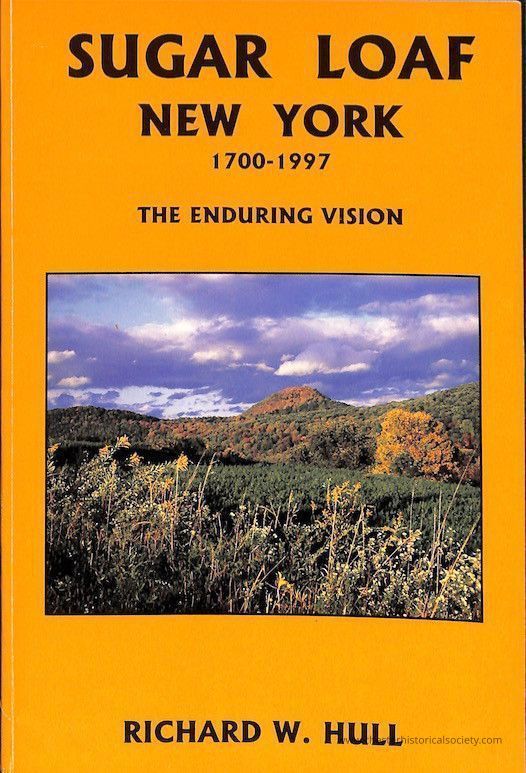Sugar Loaf, New York 1700-1997
Name/Title
Sugar Loaf, New York 1700-1997Entry/Object ID
chs-017054Description
ACKNOWLEDGEMENTS Sugar Loaf has had an almost magical ring in my ears since I first arrived in this little hamlet as a child nearly half a century ago. The word conjures up sweetness and quaintness. As a boy, we always passed through the sleepy hamlet on our way to the ridge where my parents purchased the old Predmore dairy farm in 1949. Over the years, my brother, David, transformed the property into a remarkably productive orchard. For him, 'Applewood Orchards' was a love of labor. For the rest of us it was purely love. We had to pass through Sugar Loaf hamlet to reach the farm and often we stopped to buy a few provisions. One day we bought a horse and my favorite dog, Duke, from old George Holbert, who everyday without fail sat in his little red shed and greeted people passing along Kings Highway. The building still stands, exactly as it was in the old days. Today, as I speed by on my way to New York University, I am constantly reminded of an era that is rapidly passing in Orange County. Mr. Holbert, a horse trader and farmer of the old school, would have been an ideal subject for a Grant Wood painting. Zack Swain, another fascinating character, lived at the other end of the hamlet. Old Zack resided in a candle-lit wooden cabin and gave pony rides for a living. In between was Avril Baird, who looked like a character out of a Mark Twain novel and who kept in his back shed a wonderful old whiskey-distilling contraption that harked back to the days before Prohibition. Every where you looked in Sugar Loaf you could see expansive farms filled with Holstein cows munching on clover and alfalfa. If you listened hard, you could hear the buzz of the huge saws at the Laroe sawmill. There has always been something about Sugar Loaf that draws people to it, It is a simple place with ordinary people leading quite extraordinary lives. For a quarter century, I lived with my wife in an old colonial house in the center of the community and raised my family there. It was a wonderful and unforgettable experience. It made me realize that Sugar Loaf is more than a hamlet of people… it is quite literally a state of mind. Indeed, it is the essence of America. This little saga about Sugar Loaf is an up-dated, expanded, and substantially revised edition of my earlier work, Sugar Loaf: Its History, Mystery, and Magic 1703-1980, published seventeen years ago. It is the product of more than a quarter century of research on the Sugar Loaf hamlet and its immediate environs, extending northward to Durland Hill, west to the Black Meadow Club, east to Laroe Road and south through the Sugar Loaf Valley to the Masefield farm, I wrote this essay out of a firm belief that every citizen has a responsibility to know something about the community in which one lives and works. By knowing the past we may understand the present, and plan wisely for the future. I also believe that the backbone of America is its grassroots communities -- rural, suburban, and urban. Therein lies the seeds and genius of our democracy. If we lose our sense of 'community', we will risk losing our basic freedoms. In the search for what ‘America is all about’, historians too often examine the big picture—our state and national institutions. Yet America really sprang from its small hamlets and drew its vitality from them. Today, these small communities are being swallowed up by our mass culture. Consolidations of our rail, postal, telephone and other services are obliterating our sense of community. Until now, Sugar Loaf has survived… and even thrived. This booklet explains how and why. This cannot be considered a definitive work. Much more must be done, Nevertheless, what little I have written here could not have been accomplished without the assistance of such recently-deceased eminent citizens as Leonard Baird, Avril Baird, Mary Cameron, Ezra Decker, David Demarest, Donald Barrell, Donald Clark, Myrtle Edwards, Helen Predmore, Phoebe Slaughter, Grace Roosa, Mrs. Seely Ward, Don Oppmann, and Wilfred L. Raynor. I am also deeply indebted to Bill Raynor, Billie and Mark Laroe, Chuck Shaughnessy, Roy and Alice Talmadge, Ruth and Neil van de Weert, Walter Kannon, Bill Schilling, Binny Rabinowitz, Henry Pomnares, Irmgard Kurtz, Jarvis Boone, Dick Banker, Ivan Lewis, and many others. The information herein is also the product of several decades of sifting through local newspapers and history books, personal diaries and manuscripts, surveyor’s notebooks, census records, old telephone and railroad directories, early maps, and post office records. Let us now begin our journey through Sugar Loaf's rich and fascinating history. Richard W. Hull Professor of History New York University April 12, 1997Collection
Margie NehrichCategory
Sugar Loaf

